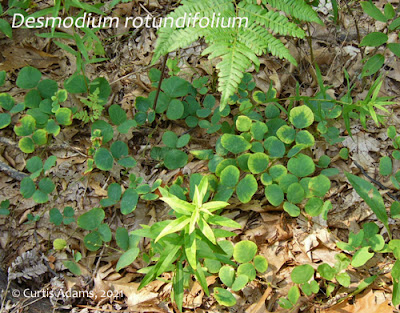The New Year brings new opportunities for trying new things in the garden as well as continuing projects from last year.
One project that I will be continuing from last year is removing and replacing vinca from a wooded area. I will be expanding that to begin removing yellow archangel, Lamiastrum galeobdolon, from an adjacent area. While this species is not currently on any official state invasive plant lists in the Mid-Atlantic, it is a species of concern. (It is a state listed invasive in Washington State. More locally it is on the Arlington County Virginia invasive plant list.) It does spread aggressively by runners and root fragments. Pulling is effective as long as all of the plant is removed. I sprayed some of it with glyphosate last fall when doing garlic mustard treatments, but I don’t know if that will be effective. Triclopyr is reported to be effective.
 |
| I really love the round leaflets of the trefoil and the way winds its way along to ground, finding openings. |
 |
| Virginia waterleaf has deeply incised leaves with whitish splotches that resemble water spots. The plants shown here are in a moist shady area near the Potomac River. Other plants in this area include Virginia bluebells, trilliums and bedstraw. Photo taken early late April. |
Another invasive that I have been fighting for a while and making some headway is Japanese stiltgrass, Microstegium vimineum. I will continue fighting it with a multipronged assault, including preemergent herbicides and lots of pulling. As I’m opening up space I’m backfilling with native species. In addition to more of the Obedient Plant, Physostegia virginiana, that I put in last fall I‘ll be adding some Virginia waterleaf, Hydrophyllum virginianium, to a moist shady area. This area is already populated by Virginia bluebells, Mertensia virginiana, lady fern, Athyrium filix-femina, and a variety of grasses and sedges. (In writing this I wonder if I should look into creating a display garden of plants with only the specific epithet of virgini--. Talk about being a plant nerd.)
 |
| The foliage on this NJ tea looks an awful lot like many Japanese spireas. Its compact size and tight clusters of white flowers in mid-summer makes an excellent replacement for exotic Spireas. |
 |
| Prairie dropseed is notable for its dense mounds of fine foliage. In late summer it sends up panicles of pink-tinged flowers. I see it as a native alternative to exotic fountain grasses. |
 |
| While I had planted tomatoes here, there was also a crop of black- and brown-eyed Susans coming in. These were all first year rosettes so they did not compete much with the tomatoes for air-space, but I imagine there was a lot of root competition. |
Speaking of fire, last year I used the garden torch to control weeds in the
vegetable garden. Areas that were cultivated
followed by flaming seemed to have fewer weeds than areas that were only
cultivated. However weeds did continue
to germinate through the spring so burning is not a one-time thing. A couple of weeks ago I went out to find a
garden bed covered in hairy cress, a winter annual weed. I got out the torch to see if I could kill
these weeds without disturbing the soil.
I checked the bed about 10 days later and most of the cress was dried
up. Aside from keeping the fire under
control, my biggest concern is damaging any in-ground irrigation lines. A quick pass of a torch is enough to melt a
soaker hose. I find the use a the torch most effect at clearing areas where the fencing is buried beneath the soil. The fire is able to reach between the holes in the chicken wire that would be otherwise inaccessible with a hoe.
 |
| The upper image is immediately after flaming the bed on the right. The cress has taken on a darker green color. 10 days later most of the cress is brown, but a few cress evaded the flame. Note that I pulled the soaker hose out of the bed before burning. |





